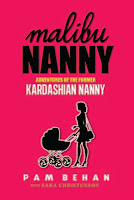Review of Malibu Nanny by Pam Behan
I typically avoid tell-all books thinking that the authors are trying to capitalize on the celebrity or popularity of others. Surprisingly, most of the book
Malibu Nanny, written by Pam Behan the former nanny of the Linda Jenner, Kris Kardashian and Bruce Jenner, doesn’t bash the large celebrity family.
The author describes caring for Linda Jenner and Bruce Jenner’s sons, Brandon and Brody Jenner for three-years. Then, when Bruce Jenner married Kris Kardashian, the author becomes the nanny to the four Kardashian kids -- Kourtney (12-years-old), Kim (10-years-old), Khloe (six-years-old), and Robert (four-years-old).
The nanny has a positive experience working for Linda Jenner and Bruce Jenner. She boasts about her friendship with Bruce Jenner and compliments as a great role model and father.
She also describes the perks of working for Kris Kardashian and Bruce Jenner. She loves traveling with the family on yachts and to Mexico, trips that she could never personally afford.
The author also shares feelings many nannies can relate to. Nannies often feel lonely living-in their employer’s home, they feel like they do not have a social life of their own, they feel like they lose a bit of their identity, and often feel consumed by the job. The author also expresses that there were not enough professional boundaries and feeling like she was working 24/7.
The nanny describes Kris Kardashian as a less-than-perfect employer. Kris didn’t compliment her nanny, but the mother was not mean either. Pam Behan describes Kris Kardashian as having high standards for herself, family, and employees – but that isn’t necessarily a bad thing. I personally prefer working for a mother that is honest about her needs and wants and doesn’t play games, in the way that Kris Kardashian Jenner is described in the book, (and we see on her television show
Keeping up with the Kardashians.
Unfortunately, at the end of the book the former nanny makes assumptions about the family that she no longer knows well. She comments on Kim’s short marriage to Kris Humphries and about the unfounded rumors about Robert Kardashian not being Khloe’s biological father.
The former nanny should not have included her opinion about the grown women she cared for 20-years ago. She no longer has a close relationship with the girls, she wasn’t invited to Kim’s wedding, and she never met Kris Humphries. Yet, she shares her opinion on the topic which I would have preferred she not include in the book.
The night I finished reading
Malibu Nanny I watched the
Keeping up with the Kardashians television show. In that show Brody Jenner confronts his father Bruce Jenner as being an absentee father that didn’t even bother calling to wish his son a Happy Birthday. His sentiments shared on the show contradict Pam Behan's view of Bruce Jenner. The nanny and author greatly admires and appreciates her friendship with Bruce Jenner and describes him as a great father, while Brody doesn't share her opinion.
Keeping Up with the Kardashians also shared that the rumors about Khloe’s paternity aren’t true.
Malibu Nanny is a quick read, making it a good summer book to read. The bulk of the book is insightful. The nanny expresses the same feelings most nannies experience and she respected the family, parents, and children in her care. I am pleased that she doesn’t bash the family but would have preferred the book ended when her nanny job ended.






















.jpg)








